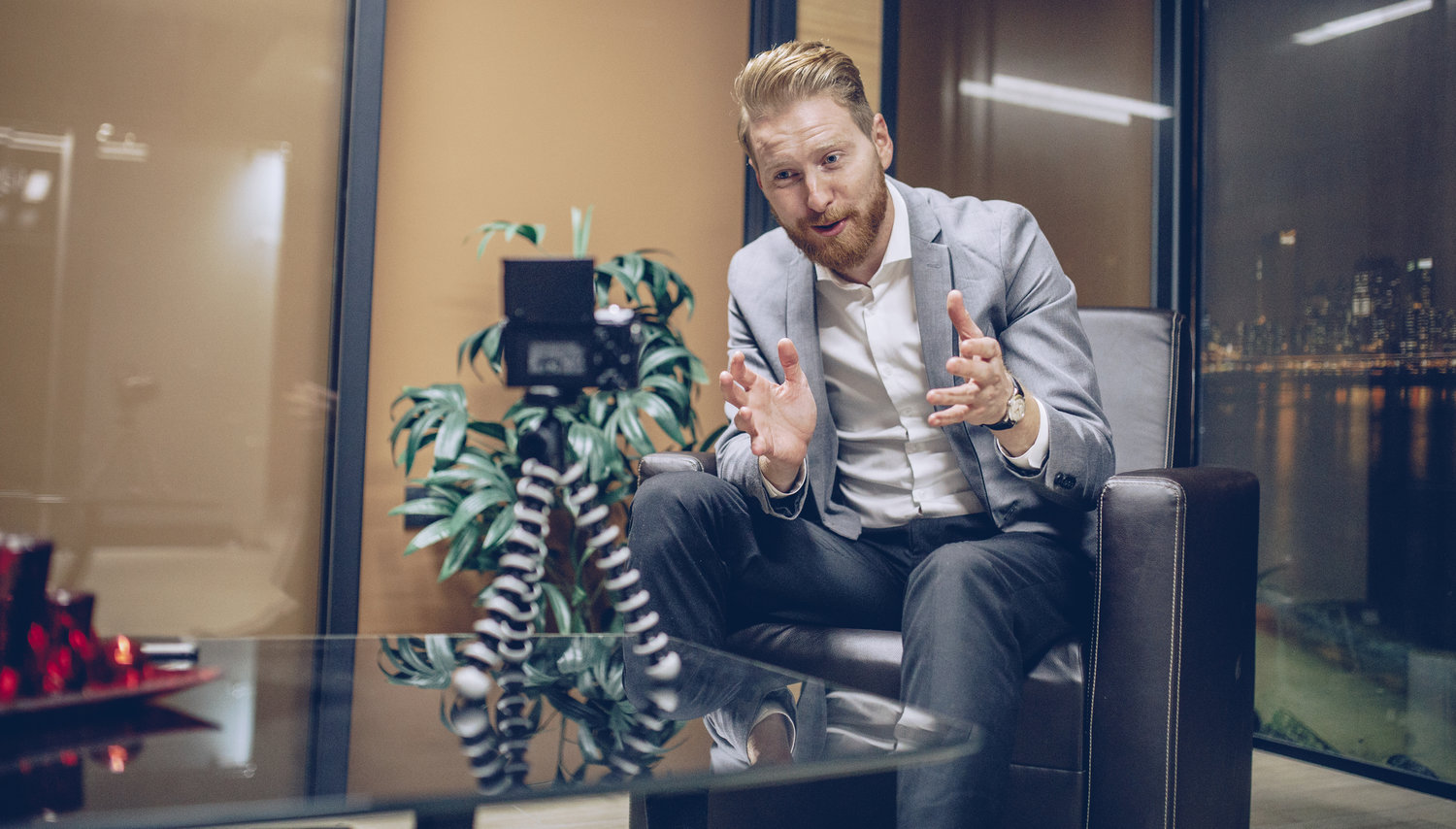Tips & Tricks - Get More out of Wipster
If you're a new user of Wipster or have just missed some of our recent updates, you might have missed some things:--Wipster's suite of integrations...
6 min read
![]() Wipster Content Team
:
Apr 11, 2018 7:35:00 PM
Wipster Content Team
:
Apr 11, 2018 7:35:00 PM

Butterflies in your stomach. Sweaty palms. Shaky legs. An insane urge to run away.
This is what performance anxiety looks like. You’ll make a plethora of excuses - not enough time and resources, who’d want to watch me anyway, what if everybody hates it - and procrastinate.

Most people go through a difficult phase of performance anxiety when they’re starting out, so you’re not alone.
However, with video marketing on a meteoric rise, you definitely can not afford to shy away from creating videos.
We’ve already discussed how you can create a professional quality video if you’re terrified of creating videos. Now let’s discuss how you can master your video fears and stage fright, and present confidently on camera.
Instead of an advantage, scripts can be a stumbling block for video-phobes. But without a script, you might stammer and blank out. So here’s what you need to do.
And your non-scripted script is ready.
Practice a couple of times. Try to memorise the intro so you start with a flow. Keep the document with all the main points in front of you (or, tape it to the wall behind your camera), so you can quickly glance at it and continue if you get stuck. Don’t read or concentrate on the points too far ahead; focus on one point at a time.
According to a study published in Science, at moments of peak pressure we find it hard to recall facts and focus on what we're doing.
A lot of times people freeze up and stammer while shooting because they’re stuck. They don’t fully understand the topic they’re speaking on. They don’t know how to explain a certain concept, give more examples than in the script, and talk like they’re an expert. Hence they come off as noobs.
So to avoid coming off as an amateur, have sound knowledge of the topic you’re planning on speaking on.
The first video is the hardest so practice, practice, practice. By practice, I don’t mean recite the script multiple times, but rehearse in the actual setting where you’ll shoot. So the following things to combat your fear of presenting in front of a camera.
Don’t be afraid to make a few blunders here and there while shooting, because you can remove them when editing. Just keep going. You can add music, interesting visuals, your brand name, social media handles, other contact details, and pretty much everything to your video. You can also shoot a cool intro and outro later on and add them to the video.
So edit your video fearlessly. Here’s a great video that shares tips and tricks to edit,
And, if you don’t want to edit your videos or want professional-quality editing, you can always hire a kick-ass editor.
It can be a little unnerving to look at a camera and speak. You may even feel weird, talking to a camera or a wall.
So, a great way to take care of those nerves is by having someone stand behind the camera/tripod, around lens level, and talking directly to them. Ask them to nod along, smile and engage with the conversation so that you can pretend you’re speaking with them, instead of an imaginary online audience or the camera.
Just make sure that your eyes are not looking away from the cameras direction, or you may look like you’re not talking to the audience!
Let your personality shine through.
If you go through popular YouTubers’ first few videos, you’ll notice that they were all a little hesitant to show their personality. Hence, they seemed awkward, shy, rigid, and uncomfortable. However, if you look at their recent videos, you’ll see a vast improvement; they’re no longer shy, their personality (OTT, wacky, sober, or otherwise) shines through and their audience loves them because of this.
Here’s a cute example. I absolutely love Kathleen Lights (beauty vlogger) and a while back she uploaded a video, ‘Reacting to my first video.’ In this video, she shares clips from her first ever video and we all had a good laugh fest in the comments section. Notice how she’s shy and awkward in those clips.
Did Kathleen Light’s disastrous first video stop her from amassing 3.5 million subscribers and creating hundreds of videos? Of course not.
Everyone, and I repeat, everyone makes terrible first few videos. That’s alright. That’s how you learn.
So, don’t be afraid. If you’re OTT, don’t try to stifle yourself and appear more serious and businesslike. Another YouTuber I absolutely love because of her loud personality is Bushra of Persuasion Revolution.
And, if your nature’s a little reserved and serious, don’t crack jokes and act funny.
So, go through old videos of people in your niche to see the glaring errors they made. Sort videos on their YouTube profile ‘Old to New’ and watch their oldest videos. This’ll help you understand that nobody shoots the perfect video from the start. Everyone starts bad and then improves on it. Same goes for you. Don’t strive for perfection. Strive to give people value through your content. Perfection will come eventually.
Wikipedia says, ‘An accountability partner is a person who coaches another person in terms of helping the other person keep a commitment.’
Your commitment is creating your first video. It’s easy for video-phobes to give one excuse after another and not start. Constant procrastination. So, if that’s you and you’re guilty of hiding behind a plethora of lame excuses, then you need an accountability partner NOW. It can be anyone who doesn’t kowtow to you and would actually be strict with you; your mum, your spouse, your boss, or you could even hire an accountability coach.
Stress on them the importance of you getting your first video up and tell them not to listen to any of your excuses. Decide when you’re going to create the video and mark it on your calendar.
Your accountability partner will ensure that you’ve created a script and are ready to shoot on this date.
Steve Cohen says in Win the Crowd:
Pure water hydrates every cell in your body and helps make your skin radiate a healthy glow. More important, water relaxes your throat, making your voice more resonant. The moist environments eliminates any resistance that is presented by a dry throat and enables you to produce a richer, more pleasant-sounding tone. On top of that, it’ll feel good. You’ll feel the resonation and reverberation of vocal tones more distinctly in your chest and nasal area. This helps you produce a better-quality sound.
Finally, drink a glass of water right before you’re about to start. Along with all the other benefits mentioned above, it will also prevent hoarseness and phlegmy throat clearing sounds which are annoying for the audience.
Your wardrobe choice can also make a huge difference on the aesthetics of your video. If you look amazing, you’ll feel confident and that will show on camera. Talking to Wistia, Nicole Otchy, founder of NCO Style, reveals a few style tips to help you look snazzy on camera.
‘Jewel tones have the right amount of saturation for all skin types and will prevent washing you out under harsh lighting. Pastels can make skin look gray and very bright colors (think neons) can make skin appear sallow.’ - Nicole
"Wearing black on camera can make dark circles appear more pronounced, giving you a more tired look." - Nicole
You can always go for a darker hue of your favourite colour if you really want to wear something dark. Navy, forest green, dark terra cotta are all great options.
Keep it simple. Don’t go for statement pieces or shiny fabrics. Choose simple fabrics and modern designs.
"Rich, saturated colors never go out of style, so it's best to keep it simple." - Nicole
“Wear a plaid tie against a solid shirt and solid jacket, or a printed shell under a solid sweater or blazer, so the print acts as an accent and not the main event.” - Nicole
“You always want to wear a color that contrasts with the background you're against so that you stand out.” - Nicole
While a white background may make every colour appear brighter than it is, darker backdrops may dullen the colours a little. So check what looks best before you start filming.
"Inaction breeds doubt and fear. Action breeds confidence and courage. If you want to conquer fear, do not sit home and think about it. Go out and get busy."
The best way to conquer performance anxiety and stage fear is to just do it. No matter how much you convince yourself that you’ll shoot a video when you feel you can, you never will. Unless you just stand up and decide to do it. So before it can cripple you any further, just go on a live video right now. Talk about anything. And once you’ve done this, sit down, create a non-scripted script, and start shooting.
It really is that easy.
If you're a new user of Wipster or have just missed some of our recent updates, you might have missed some things:--Wipster's suite of integrations...
We’re excited to announce a powerful new integration that brings Wipster’s intuitive video review tools directly into Final Cut Pro (FCP). Designed ...
1 min read